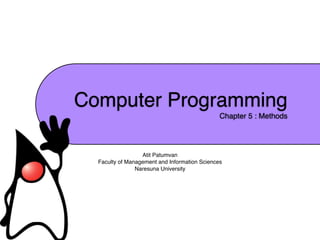
Computer Programming Chapter 5 : Methods
- 1. Computer Programming Chapter 5 : Methods Atit Patumvan Faculty of Management and Information Sciences Naresuna University
- 2. 2 โปรแกรมย่อย (Sub Program) • โปรแกรมย่อย มีตําแหน่งในการเข้าถึงชุดคําสั่งเพียงตําแหน่งเดียว • โปรแกรมหลักจะหยุดการทํางาน เมื่อทําการเรียกใช้โปรแกรมย่อย และ • เมื่อโปรแกรมย่อยทํางานเสร็จสิ้นโปรแกรมหลักจะกลับมาทํางาน ต่อในชุดคําสั่งที่อยู่ต่อจาก คําสั่งเรียกใช้โปรแกรมย่อย • โปรแกรมย่อยสามารถแบ่งออกเป็น 2 กลุ่ม • Procedure เป็นโปรแกรมย่อยที่มีการรับค่าพารามิเตอร์จาก โปรแกรมหลัก • Function เป็นโปรแกรมย่อยที่มีการส่งค่าให้กับโปรแกรมหลัก Atit Patumvan, Faculty of Management and Information Sciences, Naresuan University
- 3. 3 การใหลของชุดคําสั่งในโปรแกรม Main Program statements Sub Program methods statements statements methods call statements statements statements Atit Patumvan, Faculty of Management and Information Sciences, Naresuan University
- 4. 4 ตัวอย่างการประยุกต์ใช้โปรแกรมย่อย 01: public class PrintStar { ***** 02: 03: public static void main(String[] args) { ***** 04: System.out.println("*****"); 05: System.out.println("*****"); ***** 06: System.out.println("*****"); 07: System.out.println("*****"); ***** 08: System.out.println("*****"); 09: } ***** 10: } : 03: public static void main(String[] args) { 04: for (int i = 1; i < 6; i++) { 05: System.out.println("*****"); 06: } 07: } : Atit Patumvan, Faculty of Management and Information Sciences, Naresuan University
- 5. 5 ตัวอย่างการประยุกต์ใช้โปรแกรมย่อย 01: public class PrintStar { 02: 03: 04: public static void main(String[] args) { for (int i = 0; i < 5; i++) { ***** 05: 06: } star(5); ***** 07: 08: } ***** 09: 10: public static void star(int x) { for (int i = 0; i < x; i++) { ***** 11: 12: } System.out.print("*"); ***** 13: System.out.println(); 14: } 15: } * : ** 03: public static void main(String[] args) { 04: for (int i = 0; i < 5; i++) { *** 05: star(i); 06: } **** 07: } : ***** Atit Patumvan, Faculty of Management and Information Sciences, Naresuan University
- 6. 6 Methods • ในภาษาที่เป็นโครงสร้าง เราสามารถสร้างหน่วยของโปรแกรม (procedure) เพื่อใช้ในการแก้ปัญหาที่ต้องการให้มีการประมวลผล ที่คล้ายๆกัน โดยผู้พัฒนาโปรแกรมไม่ต้องเขียนโปรแกรมซ้ําๆ หลายครั้ง • หน่วยของโปรแกรมที่สามารถส่งค่าออกมาเราจะเรียกว่าฟังก์ชัน (function) • ในภาษาเราจะเรียกหน่วยของโปรแกรมและฟังก์ชัน ด้วยเมธอส (method) Atit Patumvan, Faculty of Management and Information Sciences, Naresuan University
- 7. 7 Method Invocation • การเรียกใช้ Method ทําได้หลายแบบ • Method ที่ไม่ส่งค่ากลับ: จะต้องถูกเรียกจากตําแหน่งประโยค • Method ที่มีการการส่งค่ากลับ: จะต้องถูกเรียกจาก term ภายใน expression • โครงสร้างการเรียกใช้เป็นดังนี้ <method_name> ([argument list]) 01: public class MethodInvocation { 02: 03: public static void main(String[] args) { 04: method(); 05: } 06: 07: public static void method() { 08: System.out.println("sub program is called"); 09: } 10: } Atit Patumvan, Faculty of Management and Information Sciences, Naresuan University
- 8. 8 การเรียก Method ที่มีการส่งค่ากลับ 01: public class FunctionInvocation { 02: 03: public static void main(String[] args) { 04: int x = 7, y = 5; 05: int z = add(x,y); 06: System.out.println(z); 07: } 08: 09: public static int add(int a, int b) { 10: int c = a + b; 11: return c; 12: } 13: } send value (parameter) caller method calee method return value Atit Patumvan, Faculty of Management and Information Sciences, Naresuan University
- 9. 9 Method Overloading • การที่เมธอสมีชื่อเหมือนกันได้มากกว่าหนึ่งเมธอส 01: public class MethoadOverload { 02: 03: public static void main(String[] args) { 04: int x = 7, y = 5; 05: double z = 5.0; 06: 07: System.out.println(x / y); 08: 09: System.out.println(div(x, y)); 10: 11: System.out.println(div(x, z)); 12: } 13: 14: public static double div(int a, int b) { 15: double c = a / (double) b; 16: return c; 17: } 18: 19: public static double div(int a, double b) { 20: double c = a / b; 21: return c; 22: } 23: } Atit Patumvan, Faculty of Management and Information Sciences, Naresuan University
- 10. 10 Parameter Passing: Pass by Value 01: public class PassByValue { 02: 03: public static void main(String[] args) { 04: String name = "alice"; 05: method(name); 06: System.out.println(name); 07: } 08: 09: public static void method(String arg) { 10: arg = "bob" ; 11: } 12: } Atit Patumvan, Faculty of Management and Information Sciences, Naresuan University
- 11. 11 Parameter Passing: Pass by Reference 01: public class PassByReference { 02: 03: public static void main(String[] args) { 04: Person p = new Person(); 05: p.setName("alice"); 06: method(p); 07: System.out.println(p.getName()); 08: } 09: 10: public static void method(Person arg) { 11: arg.setName("bob"); 12: } 13: } 14: 15: class Person { 16: 17: private String name; 18: 19: public String getName() { 20: return name; 21: } 22: 23: public void setName(String name) { 24: this.name = name; 25: } 26: } Atit Patumvan, Faculty of Management and Information Sciences, Naresuan University
- 12. 12 Scope of Visibility static instance method block block method block Atit Patumvan, Faculty of Management and Information Sciences, Naresuan University
